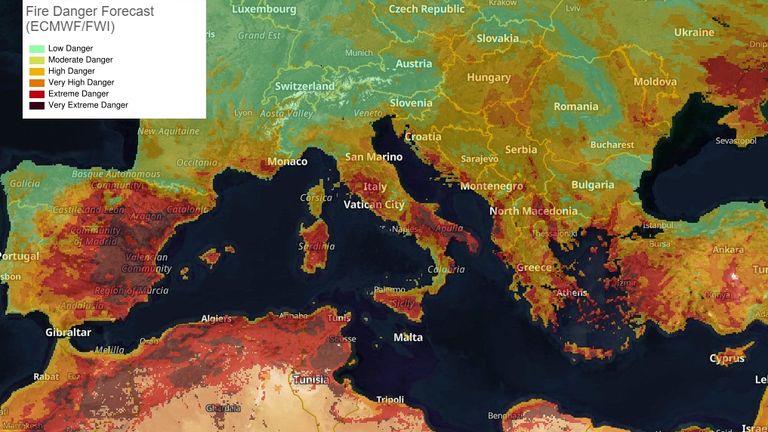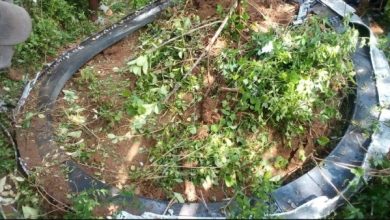High Alert: Wildfire Across Most of Southern Europe Affects Holiday Destinations
Wildfire Risks Across Southern Europe

Current high wildfire risk areas in Europe
As I observe the unfolding situation in southern Europe, it’s alarming to witness the high to extreme wildfire risk spreading across popular holiday destinations. Areas like Portugal, southern France, southern Italy, Croatia, Montenegro, Albania, Greece, and Turkey are all under significant threat, signified by dark orange and deep red zones on the European Forest Fire Information System (EFFIS) map.
Specifically, it seems that eastern Spain, the “boot” region of southern Italy, and parts of Greece are experiencing the highest danger levels.
For me, the most distressing reports are emerging from the Greek island of Evia, where evacuations have been necessary due to encroaching flames. Firefighters in Albania have faced formidable challenges combating a blaze that has threatened coastal towns. In Sardinia, the situation has escalated with a 7 km fire consuming large swathes of land, putting both residents and tourists at considerable risk.
Factors contributing to increased fire danger
The upward trend in wildfire risks can be traced back to a combination of environmental factors predominantly influenced by recent weather patterns. The relentless heat that has gripped southwestern Europe is a crucial factor. Preceding weeks have seen temperatures soar to alarming levels—37°C (98.6°F) in Mallorca and beyond—that dry out the foliage and create conditions ripe for ignition.
In addition to high temperatures, the soil moisture levels have plummeted, making the forests more vulnerable than ever. A staggering 16% of EU land has experienced early or deep drought stages, particularly hitting hard in regions that are usually thriving with greenery, like central Italy and northwestern Spain. I can’t help but connect the dots between these extreme conditions and the threats of fire that follow.
Evacuations and responses in affected regions
In light of the growing peril, authorities have not remained idle. The rapid evacuation of approximately 1,000 tourists from Puglia in Italy underscores the urgency with which local governments are responding. In Greece, nearly 18,000 firefighters have been mobilized, signifying a considerable investment in crisis management. Yet still, I worry about the impact on local economies and communities as they grapple with the challenges of maintaining safety while managing these fierce fires.
I find it notable that despite the high risk of outbreaks, authorities have managed to contain many fire incidents to smaller areas so far, but it remains uncertain how long that can last given the escalating heat and dryness.
Climate Change and Wildfire Dynamics
Impact of climate change on wildfire patterns
The connection between climate change and the increasing intensity of wildfires is becoming crystal clear. As I delve deeper into this issue, I see a pattern emerging that reveals a correlation between rising temperatures and the frequency of fire outbreaks. The summer of 2023 was recorded as one of the hottest in recent years, and looking back, I realize that climate change has led to longer and more extreme heat waves, creating an environment where vegetation can dry out swiftly.
Historically, forests in southern Europe have its wildfire season from July to September, but recent data suggests that this timeframe is elongating. With the onset of warmer and drier weather, I can’t ignore the looming reality that the summer months may expand, leaving regions vulnerable for a more extended period.
Connection between drought and forest fires
The relationship between drought and wildfires isn’t just a casual observation; it runs deeper. I learned that a warmer atmosphere is capable of holding more moisture, which paradoxically can lead to wetter conditions for some regions while leaving others parched. This dichotomy can create a deadly mix in areas that traditionally retain moisture. Elevated caution is warranted in ecosystems where drought conditions increasingly dominate the narrative.
As I reflect on this topic, I recognize how the low humidity in areas filled with underbrush significantly increases fire risk. Over time, if forest management practices don’t adapt, these dry spells can lead to more readily combustible environments.
Long-term forecasts for wildfire seasons
Looking ahead, the long-term forecasts indicate that the summer of 2024 will continue on this trajectory. Sustainable practices must be instituted to counteract these increasing risks. Local governments need to implement strategies designed to reduce susceptibility to wildfires, ensuring that lessons learned in times of crisis are converted into actionable prevention measures for the future.
Emergency Responses and Support Initiatives
EU’s Civil Protection Mechanism activation
Seeing the European Union’s proactive stance is reassuring during these trying times. The activation of the EU’s Civil Protection Mechanism is a critical response to the escalating wildfire risks. I’m encouraged to learn that numerous countries are not only acknowledging the plight of their neighbors but taking action. A Finnish cohort of experts is being dispatched to Portugal to aid in fire suppression efforts, highlighting the spirit of unity in the face of adversity.
International support for affected regions
The recent international collaboration demonstrates a shared commitment to combating these environmental challenges. Reports of aircraft and personnel being dispatched across Europe to countries facing severe wildfires underscore the importance of cooperative strategies. Spain’s response to Bulgaria on account of a massive forest fire is a salient example of this solidarity at work.
The EU’s efforts, including the mobilization of hundreds of firefighters from various member states, represent a collective approach toward the crisis. It gives me hope that with unified effort, the radius of devastation can be minimized.
Role of local firefighting resources
Yet, it’s not just international support that matters; local resources must be maximized. The local firefighting units are often the first responders in such dire circumstances. I’m heartened to see that many countries have made significant investments in bolstering their firefighting capacities over the years. Firebreak zones are being established to mitigate the spread of flames, and prescribed burns are being employed in some areas to control excess biomass.
Environmental and Economic Implications
Damage to ecosystems due to wildfires
The toll that wildfires take on ecosystems is heartbreaking and bears long-lasting consequences. As I examine the impacts, it becomes clear that both flora and fauna suffer terribly during such events. The loss of biodiversity can take years, if not decades, to recuperate, particularly in forests where the role of tree canopies and soil compositions is severely altered due to fire damage.
In some instances, areas that are supposed to recover quickly may actually shift in identity, making them less suitable for the particular wildlife that once thrived there. This is particularly poignant when I think about the interconnectedness of ecosystems and the cascading effects that can arise from a single event.
Economic costs associated with fire outbreaks
From an economic perspective, the costs don’t just end with immediate firefighting endeavors. Destruction of property, loss of tourism income, and the long-term recovery and funding needed to restore damaged areas present a multi-faceted economic burden. Increased insurance costs and emergency response funding can strain local and national budgets, further complicating recovery efforts.
As someone who follows environmental news, I can’t help but wonder about the long-term financial implications for these regions. Effective disaster preparedness can somewhat cushion these blows, but it’s crucial that stakeholders prioritize sustainable development efforts to alleviate future risks.
Recovery and prevention strategies moving forward
Moving forward, I recognize that recovery strategies must be a blend of immediate response and long-term prevention. Given the lessons learned from past summers, it’s essential to reinforce community-level preparedness and bolster the dialogue around sustainable fire management practices. I believe that education and engagement will be instrumental in promoting community resilience against wildfires. The importance of local involvement in these discussions cannot be overstated.
FAQs
What regions in southern Europe are currently facing extreme wildfire risks?
Currently, regions including parts of Portugal, southern France, Italy, Greece, and Croatia, as well as southeastern Spain, are facing extreme wildfire risks. Areas most visibly affected are emergency evacuation zones in Greece and popular tourist destinations in Italy.
How do heatwaves contribute to the severity of wildfires in southern Europe?
Heatwaves play a critical role by elevating temperatures beyond typical thresholds, which leads to the drying out of vegetation and makes fire initiation more likely. Such extreme conditions also increase the intensity at which a fire can spread.
What measures are being taken by authorities to address the wildfire risks in holiday hotspots?
Authorities are employing a mix of responses ranging from evacuations, mobilizing local and international firefighters, activating emergency response mechanisms, and establishing firebreak zones to control the spread of potential fires in high-risk areas.
How does climate change influence the patterns and frequency of wildfires?
Climate change has been linked to increasing temperatures and altered precipitation patterns, leading to prolonged droughts and consequently, higher frequencies of wildfires. Changes to the environment are putting stress on ecosystems, creating conditions for longer and more intense wildfire seasons.
As summer continues, it remains essential for everyone to remain vigilant, prepared, and responsive in the face of these natural challenges. Through concerted effort and adaptive strategies, it’s possible to safeguard both human lives and precious ecosystems from the increasingly destructive force of wildfires.








